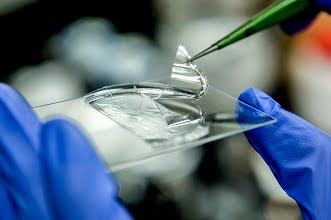A novel fabrication method has achieved a device-friendly nanocomposite thin film that produces circularly polarized light. The simple and cost-effective technology could aid disease monitoring and diminish the disruption caused by follow-up medical treatment for cancer survivors and other patients.
Circular polarization coils light into a 3D helix shape that can spin in either clockwise or counterclockwise. The phenomenon is invisible to the human eye and is rare in nature. It’s being explored for a detection process that searches for signs of the disease in blood. Currently in the research stage, the process requires large, expensive machines to generate the circularly polarized light.

Image of the fabrication process for a flexible film that induces circular polarization of light. Courtesy of Joseph Xu/Michigan Engineering Communications & Marketing.
The detection process identifies biomarkers such as protein and DNA sections that are present in the blood from the earliest stages of cancer recurrence. First, synthetic biological particles are made to be attractive to such biomarkers. The particles are coated with a reflective layer that responds to circularly polarized light, then added to a small blood sample from the patient. The reflective particles bind to the natural biomarkers, and clinicians can see this when they examine the sample under circularly polarized light.
Researchers from the University of Michigan believe their thin film could provide a simpler, less expensive way to induce polarization. They envision incorporating the film into a portable smartphone-sized device that could quickly analyze blood samples for use by doctors, or potentially even at home.
"This film is light, flexible and easy to manufacture," said professor Nicholas Kotov. "It creates many new possible applications for circularly polarized light, of which cancer detection is just one."
Another key advantage of the film is that it stretches. Light stretching causes precise, instantaneous oscillations in the polarization of the light that's passed through it, which change the intensity of polarization, alter its angle or reverse the direction of its spin. Controlling such features could enable doctors to change the properties of light, like focusing a telescope, to zero in on a wider variety of particles.

Image of the material used to make a flexible film that induces circular polarization of light and could one day help doctors detect cancer. Courtesy of Joseph Xu/Michigan Engineering Communications & Marketing.
To fabricate the film, the research team started with a rectangle of polydimethylsiloxane, or PDMS, a flexible plastic used for soft contact lenses. They twisted one end of the plastic 360° and clamped both ends down. They then applied five layers of reflective gold nanoparticles — enough particles to induce reflectivity but not enough to block light from passing through. They used alternating layers of clear polyurethane to stick the particles to the plastic.
"We used gold nanoparticles for two reasons," said Yoonseob Kim, a graduate student research assistant in chemical engineering. "First, they're very good at polarizing the kind of visible light that we were working with in this experiment. In addition, they're very good at self-organizing into the S-shaped chains that we needed to induce circular polarization."
Finally the researchers untwisted the plastic. The untwisting motion caused the nanoparticle coating to buckle, forming S-shaped particle chains that cause circular polarization in light that's passed through the plastic. The plastic can be stretched and released tens of thousands of times, altering the degree of polarization when it's stretched and returning to normal when it's released over and over again.
A commercially available device is likely several years away. Kotov also envisions the use of circularly polarized light for data transmission and even devices that can bend light around objects, making them partially invisible. The University of Michigan is pursuing patent protection for the technology.
The research was published in Nature Materials (doi: 10.1038/nmat4525).